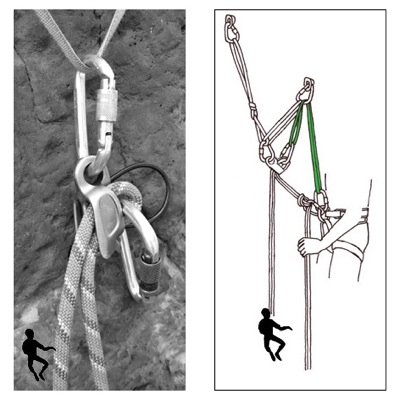ATC Guide by American company Black Diamond is practical and very popular belay device. It belongs to a group of belay devices which are in the Czech Republic called the “buckets”. Its construction is based on the early Sticht plate. It is possible to dynamically belay both leader and the second, while the second can be belayed by tope rope belay either with the body or from top belay station. Moreover, in the case of the seconding climber belay from top rope belay we can use self-locking feature of this belay device. ATC Guide can be used for ropes of diameters from 7.7 mm to 11 mm. We can use either single rope or two-strand rope (either half rope or twin). When using two-strand rope each strand is pulled through its own longitudinal opening in the body belay device. Rope is inserted into the ATC Guide in a manner standard for this type of belay device, which means that you create a bight on the rope, and the top of the bight is inserted into one of the main longitudinal openings. Then you will connect it by locking carabiner to the harness, the carabiner will together with rubber tube of the belay device clip to a bight created by bending of the rope. This supplemental rubber tube does not have any load-bearing function; its purpose is only to hold the belay device close to the harness (or anchor point). On the side of ATC Guide are visual symbols that determine which end of the rope has to go from the belay device towards the climber. These symbols are designed for basic and recommended position at which is the dead part of the rope (part of the rope we hold by hand) lead through a tapered notch with grooves at its walls. This notch increases braking effect of the belay device, because the rope is in restricted space pressed and thus achieves greater friction. If we feel that the rub of the rope in the belay device is too high, we can turn the belay device so the notches will point toward the active part of the rope (i.e. one that leads to the climber – be careful, at that moment the symbols cease to apply). The braking effect will decrease and the can be easily pulled. Estimation of optimal braking force is a matter of experience and practice, therefore it is recommended for beginners to seek an advice from an experienced person or, as prevention, always used the way to insert the rope recommended by the manufacturer and shown by the symbols. Climbing ropes of small diameters are always inserted according to symbols to increase the braking force.

Protection of the second with the self-locking function
ATC Guide allows the protection self-locking function. In this way is possible to provide a protection to either one seconding climber, as well as to two seconding climbers simultaneously. For example, for a progress of a three-man team represents the simultaneous progress of two second climbers significant saving of time. Self-locking effect is activated when the second climber puts a load on the rope. That causes pressing of the top strand threaded through the belay device against the bottom strand and thus its pinching. Hangdogging second actually blocks his/hers rope himself/herself. This way belayer on the belay station don’t have to permanently hold the dead part of the rope in his hand, he/she just have to take up the slack in stages, as the second progress upward. Belayer will appreciate this especially during the winter when he/she has numb fingers.
However, if the second climber, who is belayed by this self-locking method, cannot climb over a difficult place and hang on the rope, blocks the rope by his/hers own weight and therefore it is not easy to lower him/her. One of the ways how to lower him/her is to lift the carabiner clipped in the rope’s bight or turn the belay device.

Continued in the book >>

